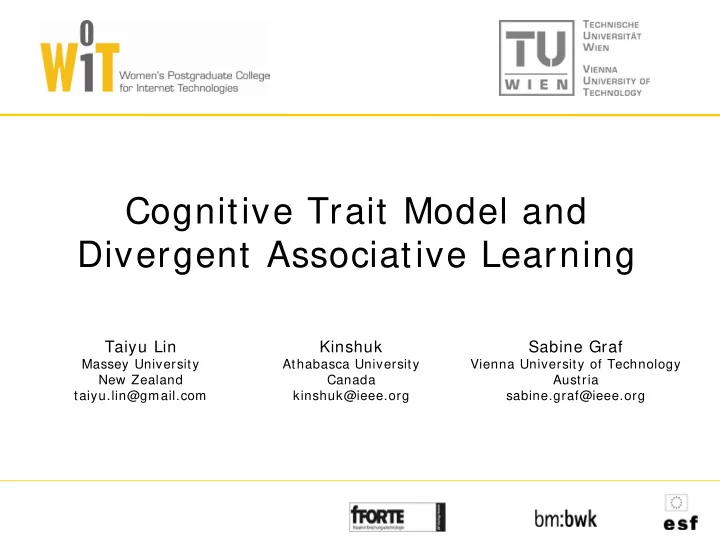

Cognitive Trait Model and Divergent Associative Learning Taiyu Lin Kinshuk Sabine Graf Massey University Athabasca University Vienna University of Technology New Zealand Canada Austria taiyu.lin@gmail.com kinshuk@ieee.org sabine.graf@ieee.org
Motivation � Cognitive Trait Model is a student model that aims at creating profiles of learners’ cognitive traits by analysing learners’ interactions with the learning system � Information about cognitive traits can be used to avoid cognitive load in educational systems in terms of providing adaptive courses � Cognitive traits are more or less stable over time � CTM can still be valid after a long period of time � CTM is domain independent and can be used in different learning environments, thus supporting life long learning � CTM includes � Working Memory Capacity � Inductive Reasoning Ability � Divergent Associative Learning 2
Implementation of Cognitive Trait Model Trait M Tr Model Trait M t Model Ga Gatewa teway y Performance Pe Based M Ba Model l onent. Action Ac Individualized T Trait N Networ orks C Comp mpon History Hi Action on H History C Compon onent … … ITN 1 ITN 2 ITN n Interface L Listen ener er C Componen ent MOT D Detector or C Comp mpon onent … …… . MOT 1 MOT 2 MOT n Learne ner I r Interfa rface 3
Divergent Associative Learning � Divergent Thinking � Hudson, 1966 (thinking style) � Convergent: – Good in seeing information leading to a restricted answer or solution � Divergent: – Good in creating many responses to a single stimulus (or finding a greater variety of answers to a problem) – More creative [ http: / / www.learningandteaching.info] 4
Associative Learning � Based on the assumption that association can be formed between simple events or stimuli � One end of the association is called the stimulus and the other the response � The stimulus and response constitute a pair to be learned � paired–associate learning Stimulus Response 5
Divergent Associative Learning � inherits characteristics from divergent thinking and associative learning � Basic idea: learners develop links between new and existing concepts � creates divergent-style associations from the new concept to existing concepts 6
Differences of DAL to divergent thinking and associative learning � DAL & Divergent Thinking � Divergent thinking results in new concepts or ideas while the “end products” of DAL are new associations between the new concept and existing concepts � Focus of divergent thinking is directed forwards into an unknown space (novel and original ideas), whereas the focus of DAL is directed backwards to what has been learned before � DAL & Associative Learning � While associative learning is a one-to-one association, DAL supports one-to-many associations 7
Web-DAL � A instrument was developed for measuring learners’ DAL � Online accessible � Two steps: � Participants learn a new concept � Participants are asked to use Web-DAL to write down as many related concepts as possible in one minute � The new concept should be from a domain that the participants are familiar with � Measure of DAL: � Total number of answer items � Originality of answer items (where the originality refers to the inverse of the items frequency of occurrence in the entire sample) 8
Web-DAL � Web-DAL is based on commonly used approaches for measuring divergent thinking skills (Alternate Uses Test) � In contrast to divergent thinking tests, Web-DAL involves learning and asks participants to create divergent associations to existing knowledge � In contrast to association learning tasks, Web- DAL focuses on long-term associative learning � duration between learning and testing takes weeks or months 9
DAL in Cognitive Trait Model � Cognitive trait model used six manifests of traits (MOT) to create approximations of students’ DAL: � Associative hierarchy � Classification ability � Versatile navigation � Relevance filtering � Domain performance � Working memory capacity 10
Empirical Study � Aims at comparing the approximation from the CTM with the results of Web-DAL in order to evaluate the proposed approach � Participants: 14 students from Massey University, New Zealand (studying in Information Systems course) � Participants used a learning system that tracked their behaviour � The new concept was about Information Technology Infrastructure and PHP programming � Read the descriptions � Take a quiz consisting of multiple-choice questions � Participants were asked to perform Web-DAL 11
Result � Variables � Total number of answer items (Web-DAL) � Originality of answers (Web-DAL) � Approximations of DAL from Cognitive Trait Model � Correlations between results from CTM and Web-DAL rho p Number of answers & result from CTM 0.499 0.035 Originality of answers & result from CTM 0.653 0.006 � These correlations support the use of CTM to create DAL profiles of learners 12
Conclusions � Cognitive trait model (CTM) aims at creating cognitive profiles of learners based on their behaviour in an online course � We demonstrated how divergent associative learning can be included in the CTM � Evaluation was done by comparing the results of CTM with the results from Web-DAL, a psychometric instrument for measuring the DAL of learners � Results supports the use of CTM to create DAL profiles of learners 13
Recommend
More recommend